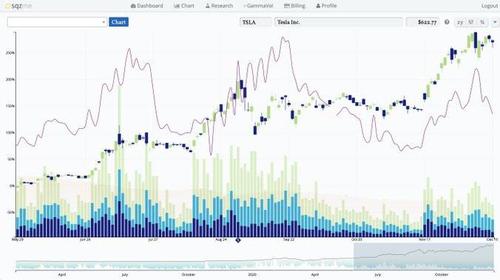Tesla’s Addition To The S&P Could Cause A “Deluge” Of Selling In Other Index Components
Tyler Durden
Fri, 12/18/2020 – 12:40
Tesla’s inclusion into the S&P index may not be all sunshine and rainbows for the other companies already in the index. Tesla’s enormous size – coming in at a valuation of $600 billion – will make it the sixth largest market cap in the index and the largest entrant by market value in history.
Since it is replacing a much smaller company in “Apartment Investment and Management Co.”, the carmaker’s addition could wind up setting up serious volatility for other index components. In fact, Citadel’s head of trading, Greg Sutton, says that even though SPY funds will have to buy more than $70 billion worth of Tesla shares, they’re also going to have to “dump an equal amount of stock in existing members” of the index.
These stocks may have troubling managing what Bloomberg is calling a “sudden deluge of supply”.
This deluge, he told Bloomberg, could cause “intense selling pressure that could lead to dislocations”. It was these types of dislocations that had prompted the index to consider adding Tesla in two shots instead of one – an idea the index has passed on in favor of adding Tesla in one shot. The potential companies that could feel the aftershock of the addition include names like Procter & Gamble, Berkshire Hathaway and Johnson & Johnson. Bloomberg notes:
The trio is estimated to each have a number of shares to be disposed that is equal to the average daily trading volume in the past three months. While that may not sound like a lot, imagine if the selling flares up in the final minutes of Friday’s session, the last window of trading before Tesla’s entry. That’s the time when passive investors tend to step up transactions so as to track the benchmark as close as possible.
Sutton commented that this is going to cause more selling in other S&P components: “Adding it all at once creates more stock that needs to be sold for the funding trade, which potentially creates more impact — especially in less-liquid components of the S&P 500. The market can digest it, but there is the potential for liquidity impact.”
Ben Johnson, director of global ETF research at Morningstar Inc., said that money managers will use tools like options and MOC orders to help adjust position sizing: “They’re going to be pulling out all the stops. They are not going to be taking any one singular approach, not using any one tactic in isolation, but using all of the different tools that are available to them to try to again leave no footprint and minimize the cost to their investors.”
Howard Silverblatt, senior index analyst at S&P Dow Jones, commented: “It’s things that they’ve all done before, just not on this magnitude. There should be a lot of commotion, but hopefully it goes smooth.”
The “commotion” could continue well after Tesla’s inclusion into the index, as well. Recall we also noted on Friday morning Twitter user @Squeezemetric’s astute analysis that Tesla’s inclusion into the S&P index could actually be the catalyst that bursts the company’s bubble.
How S&P inclusion bursts the Tesla bubble:
Ever since June (at $200/share), Tesla stock has been driven by a perpetual motion machine of hype and call option flows — nothing more. And everyone knows it.
Here’s what not everyone knows:
- When a stock joins the S&P 500, it becomes part of a massive volatility complex, which is a terrifying web of arbitrage and pseudo-arbitrage relationships. Tesla will join the index as a top-ten component of a cap-weighted index. It’s big.
- Its bigness will allow all manner of dispersion, relative value, and market-making traders to begin relying on Tesla’s newfound correlation to the index. This will invariably cause arbitrageurs to buy SPX options/vol and sell TSLA options/vol to “close the spread.”
- Since Tesla stock is driven by the returns on call options, it is a slave to “vanna”: the relationship between option prices (implied volatility) and delta (stock exposure).
In other words, since June, $TSLA goes up only when implied volatility (IV) goes up (purple line is IV).
When Tesla joins the index, these historic call option flows and the hype machine behind them will hit the big red fire truck that is the S&P, at 500mph.
Implied volatility will be unable to rise. Call options will bleed value. New flows will be absorbed by real traders.
With the call option hype trade hampered, the stock will have no possibility of further returns — a deliciously ironic end to the ugliest of Robinhood’s many ugly children.
And an appropriately ironic fate for Tesla – a victim of its own “success.”
You can read our full article, which contains analysis of numerous scenarios for Tesla after its index inclusion, here.
via ZeroHedge News https://ift.tt/2KHkGxF Tyler Durden


